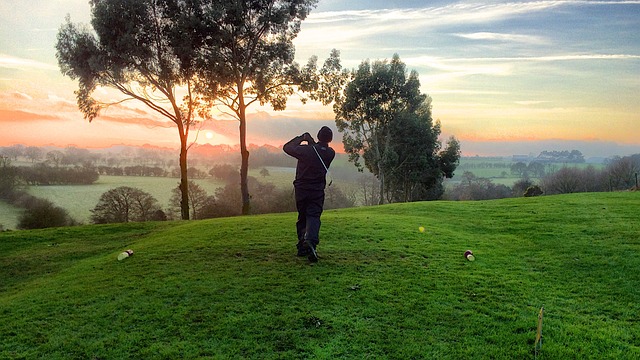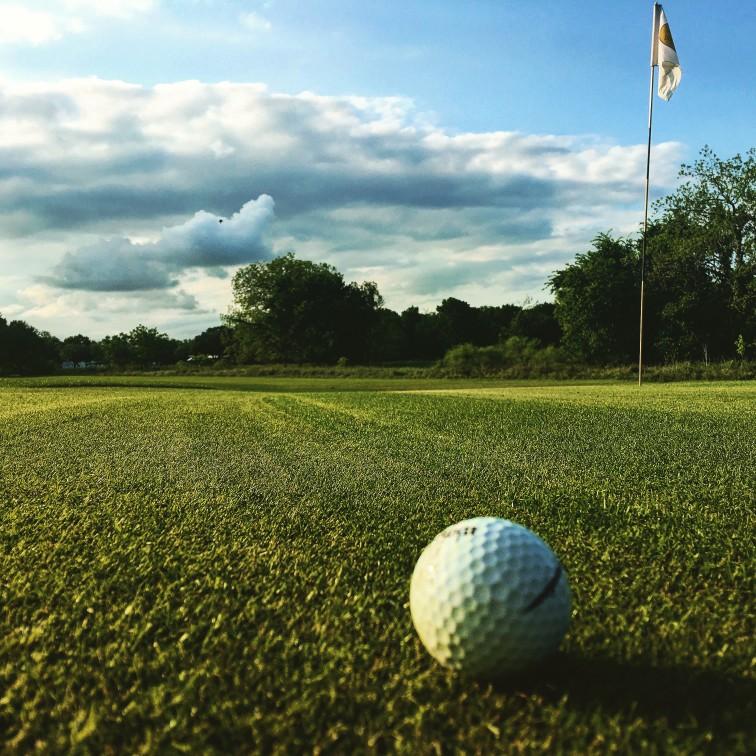Golf is a beloved game enjoyed by individuals of all ages and abilities. The popularity of golf has been steadily increasing, and for good reason.
This classic sport provides an opportunity to spend time in nature, socialize with friends, and practice a lifetime of skill-building. Unfortunately, for many, the first tee can be an intimidating and overwhelming experience.
Introduction
The “first tee nerves” refers to the feeling of anxiety and fear that often comes with taking your first shot. It can be caused by a combination of factors, including fear of being judged, a lack of confidence, and the physical pressure of being in the spotlight. Regardless of the source, tackling first tee nerves is essential for any golfer who wants to truly enjoy the game.
Overcoming first tee nerves is an important goal. Mastering the initial anxieties can help golfers to relax and enjoy the game, as well as improve their performance. Confidence on the first tee can lead to higher scores, increased motivation, and a greater love of the game.
In order to maximize your potential on the golf course, it is essential to understand the strategies for tackling first tee nerves. In this article, we will discuss the steps for overcoming the fear of the first shot, including identifying and addressing the sources of fear, mental and physical preparation, developing confidence, and seeking professional coaching.
By implementing the strategies outlined in this article, golfers of all levels of experience can experience improved performance and increased enjoyment of the game. With a few simple strategies and a bit of practice, you can be teeing off with confidence and setting yourself up for success.

Identifying Your Fears
Golf is a mental game as much as it is a physical one, and being able to identify your fears and anxieties on the first tee is an important step in overcoming the jitters. Taking the time to recognize your internal dialogue and understand what triggers your fears can be an invaluable tool for mastering your first tee nerves.
Recognizing your fears is the first step in the process of overcoming them. If you’re feeling anxious, take a few moments to explore the source of your anxiety. Are you afraid of embarrassment? Do you lack confidence in your abilities? Do you feel pressure to perform for your teammates or family members? By taking the time to acknowledge your fears, you can begin to take steps to address them.
It’s also important to understand why your fears exist. Are your fears based on a real or perceived threat? Do you have a history of poor performance on the first tee? Do you have unrealistic expectations of yourself or of the game? By understanding the roots of your fears, you can begin to tackle them in a more focused and effective manner.
It’s also helpful to consider the mental attitude you bring to the course. Does the thought of playing make you anxious or excited? Are you focusing on the challenge of improving your game, or the fear of making mistakes? Are you working on developing a positive mindset that will help you to respond with resilience to setbacks and challenges?
Finally, it’s important to consider other factors that may impact your mental game. Are you well rested and hydrated? Are you getting enough sleep? Are you eating a healthy diet? All of these factors can impact your confidence and performance on the course.
By taking the time to recognize your fears and understand their source, you can begin to develop an effective strategy for overcoming your first tee jitters. With a better understanding of your fears, you can begin to develop the mental and physical skills needed to conquer them.
Mental Preparation
For many golfers, the fear of taking the first tee shot can be overwhelming. This fear can be caused by several factors, such as a lack of confidence or experience. Fortunately, there are methods that golfers can use to help them overcome this fear.
The first step in preparing mentally for a golf round is to establish a pre-round routine. This routine should include activities that focus on calming nerves, such as deep breathing or listening to relaxing music. This routine should also include visualization exercises, where you imagine yourself hitting a perfect shot off the tee. Visualizing yourself hitting a great drive will help you focus and remain positive throughout your round.
It is also important to stay positive and confident during your round. Be sure to focus on the positives and not the negatives. If you hit a bad shot, take a deep breath and try to stay positive. Remind yourself that everyone makes mistakes, and the important thing is to move on and focus on your next shot.
Another important part of mental preparation is to set achievable goals for the round. By setting realistic goals, you can help motivate yourself and stay focused on the task at hand. For example, if you are a beginner golfer, you may set a goal of hitting the fairway with every tee shot. Or, you may set a goal of shooting under a certain score for the round. Setting achievable goals will help you stay focused and confident on the course.
Finally, practice is key when it comes to developing mental preparation for golf. Try to practice regularly and focus on the fundamentals of the game, such as your grip, stance, and swing. The more you practice, the more comfortable you will become on the course and the more confident you will be when it comes to teeing off.
By following these strategies for mental preparation, golfers can help reduce their fear of taking the first tee shot and maximize their chances of success on the course.
Physical Preparation
When overcoming first tee jitters, preparation is key. It’s important to dedicate time to physical preparation before hitting the course. Incorporating relaxation techniques can help reduce tension and lower your heart rate, allowing you to approach the first tee with a more relaxed state of mind.
Deep breathing exercises can be especially helpful for calming the nervous system. Once you have found a comfortable position and closed your eyes, focus on your breath. Take deep, slow breaths, and gently let your chest and abdomen expand. With each exhale, focus on letting go of any tension that may be building. Continue this for five to ten minutes until you feel relaxed.
Having a solid golf swing will enable you to hit the ball with confidence. Work with a professional to identify any flaws in your technique. If necessary, make adjustments to your swing to ensure accuracy and consistency.
It’s important to practice regularly to ensure your body is physically prepared for golf. Schedule dedicated practice time and focus on developing your fundamental golf swing. Take the time to understand the right stance, grip, and posture that suits your game.
Hit practice shots on the driving range or chipping green. Golf pros often recommend a pre-round warm-up that includes stretching and light exercises. Build up to a full swing by hitting short, medium, and long-distance shots. This will help to prepare your body for the round ahead.
Finally, it’s important to stay hydrated when you’re on the golf course. Carry a water bottle with you and make sure you drink regularly. Your body needs plenty of water to stay alert and focused.
Physical preparation is an important part of overcoming first tee jitters. Incorporating relaxation techniques, perfecting your golf swing, setting achievable goals, and staying hydrated will help you to hit the course with confidence.

Developing Confidence
Playing golf with confidence is something that can be learned and mastered with practice. Building confidence can help golfers understand their fears and anxieties, as well as how to manage them. To build confidence, golfers can start by setting achievable goals and incorporating them into their practice routines.
Golfers should start by setting realistic goals. Goals should be achievable and achievable within a certain time frame. It helps to break bigger goals into smaller, more manageable parts. For example, if a golfer is aiming to improve their putting, they can break this goal down into smaller goals such as focusing on their stance, grip, and follow-through on each putt. Setting and achieving smaller goals can lead to larger successes.
Once achievable goals are set, golfers should create a regular practice routine. A regular practice routine should include physical practice, mental practice, and relaxation techniques. The physical practice involves regular time on the golf course, as well as time in the range. During physical practice, golfers should focus on perfecting their golf swing and other physical aspects of the game. Additionally, golfers can use physical drills to help them improve their accuracy and power.
Mental practice should include visualization, positive self-talk, and goal-setting. Visualization involves picturing how one wants to play, and then working toward that goal. Positive self-talk is important for golfers to identify and overcome negative thoughts. Additionally, golfers should set achievable goals and think about the strategies needed to achieve them.
Finally, relaxation techniques are important for golfers to incorporate into their practice routine. Techniques such as deep breathing, progressive muscle relaxation, and visualization can help golfers stay relaxed and focused during their rounds of golf. Additionally, relaxation techniques can help golfers deal with their anxiety and fear on the course.
Developing confidence also involves working with a professional golf coach. A professional golf coach can provide insight and advice that can help golfers improve their game. They can help golfers identify and overcome their fears, as well as provide strategies to help them achieve their goals. Additionally, they can provide feedback and encouragement which can help golfers stay motivated and confident.
Developing confidence is an important part of mastering first tee nerves. Setting achievable goals and creating a regular practice routine can help golfers build the confidence needed to play their best. Additionally, professional coaching can provide insight and advice needed to help golfers improve and achieve their goals. With practice and dedication, golfers can learn to overcome their first tee jitters and play with confidence and success.
Acknowledging and Accepting Mistakes
The fear of making mistakes is one of the biggest reasons why golfers experience first tee nerves. When we are afraid of failure, we are more likely to tense up and make a bad shot. That’s why it’s important to acknowledge and accept mistakes as part of the learning process.
When it comes to golf, mistakes are inevitable. The more experience you gain, the more mistakes you’ll make. But, instead of seeing these mistakes as barriers, it’s important to recognize them as opportunities to learn and improve.
A great way to start acknowledging and accepting mistakes is by taking time to reflect on your performance. After each round of golf, take a few minutes to look back and review what you did well and what you could have done better. This will allow you to identify mistakes that you can work on and correct in the future.
Trying to be perfect can be debilitating and lead to performance anxiety. Instead, focus on making progress. As long as you’re consistently working on and improving your game, you’ll still be successful.
It’s also important to develop a positive attitude. It’s natural to feel frustrated after a bad shot or a bad round of golf, but it’s important to stay focused on the process and not the outcome. Acknowledge that mistakes are part of the learning process and that you’ll be a better player when you accept them.
Developing a sense of resilience is also key. When you make mistakes, don’t dwell on them and don’t let them affect your attitude. Instead, take a step back and analyze what you did wrong and how you can improve. Use this as an opportunity to learn and grow, and your game will improve over time.
Finally, it’s important to remember that it’s ok to make mistakes. As long as you’re willing to learn from them, you’ll be able to move on and perform better next time. Acknowledge your mistakes, accept them, and then move on. With practice and perseverance, you’ll be able to overcome first tee nerves and become a confident golfer.
Professional Coaching
For golfers who are looking to take their game to the next level, professional coaching can be a valuable resource in learning how to overcome first tee nerves. Working with a professional coach can provide a personalized strategy and help to create a training plan that is tailored to the individual golfer’s needs.
Professional coaches can help golfers to gain confidence in their abilities and become more comfortable in on-course situations. By evaluating the golfer’s swing and providing personalized instruction, a coach can help a golfer to identify areas for improvement and develop a plan for success. Through the use of drills and practice sessions, a coach can also help a golfer to become more comfortable with the technical aspects of the game.
Professional coaches can also provide mental and emotional support. Coaches can assist golfers in developing and mastering the mental game of golf. A coach can help a golfer to recognize the mental obstacles that may be causing first tee nerves, and develop strategies to help increase confidence and reduce anxiety. Coaches can also provide feedback and encouragement throughout the learning process, helping to motivate the golfer to persevere in the face of setbacks.
One-on-one instruction can also help golfers to become more aware of the physical aspects of the game. Through a combination of video analysis, drills, and on-course instruction, a coach can help to perfect the golf swing and provide feedback on how to make the most of each shot. With the help of a professional coach, golfers can become more confident in their abilities and learn how to better control their body and their swing on the course.
Finally, professional coaching can help to reduce golfing costs. Knowing the right techniques and tools can help a golfer to save money on expensive lessons and equipment. Through working with a coach, golfers can ensure that they are taking the most efficient route towards improvement and achieving their goals.
Professional coaching can help golfers to develop the necessary skills to overcome first tee nerves and take their game to the next level. With the help of a coach, golfers can learn how to recognize and control their anxieties, improve their mental and physical skills, and ultimately become more confident and successful on the course.
Conclusion
The goal of playing golf with confidence is to overcome the fear and anxiety associated with the first tee. By preparing both mentally and physically, you can set yourself up for success and take your game to the next level.
Identifying your fears and understanding what causes them is the first step in conquering your first tee jitters. Take the time to recognize the anxieties that can keep you from playing your best and work to develop strategies for managing them.
Mental preparation is essential in developing the confidence you need for performing on the course. Establish a consistent pre-round routine and visualize yourself achieving success. The power of positive thinking is key to setting yourself up for success.
Physical preparation involves mastering your golf swing and incorporating relaxation techniques to help you stay calm under pressure. Investing in private instruction or taking a golf clinic will help you fine-tune your technique and make adjustments as needed.
The key to playing with confidence is practice. Make a commitment to practice regularly, set achievable goals, and remember that mistakes are part of the learning process. Acknowledging and accepting your mistakes and taking steps to improve will help you develop your skills and your confidence on the course.
Playing golf with confidence requires hard work and dedication, but the rewards are worth it. With the right strategies and support, you can overcome your first tee nerves and enjoy the game of golf. This is your opportunity to take your game to the next level and experience the joy of playing with confidence.


